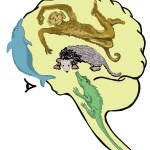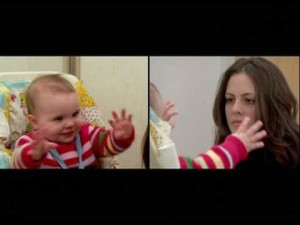From Don’t Try This Alone: “ My Feb. 7 post ‘Love Theory’ introduced A General Theory of Love (GTL), the best book I’ve seen on the three-part or ‘triune’ brain and human emotions. Basic survival instincts are in the reptilian brain, mammalian emotions are in the limbic brain, thought is in the frontal lobe.
My Feb. 7 post ‘Love Theory’ introduced A General Theory of Love (GTL), the best book I’ve seen on the three-part or ‘triune’ brain and human emotions. Basic survival instincts are in the reptilian brain, mammalian emotions are in the limbic brain, thought is in the frontal lobe.
After adding that the brain’s distinct parts create a ‘stove-pipe’ problem because they don’t communicate well with one another, GTL proceeds to Attachment Theory. The very development of an infant’s brain after birth, they say, depends utterly on the mother’s close affectionate attention, using a deep eye contact they dub ‘limbic resonance.’ If the baby doesn’t get deep eye contact and attunement? Brain damage.
. . . ‘Mothers use the universal signals of emotions to teach their babies about the world,’ begins GTL. ‘Babies continuously monitor their mothers’ expressions. If a mother freezes her face, her baby becomes upset and begins to cry in short order…
‘Why should a creature with relatively few skills be so monomaniacally focused on tiny muscular contractions beneath the skin of another creature’s body? Emotionality enables a mammal to sense the inner states and the motives of the mammals around him…
‘A baby is born with almost no limbic programming. It needs continual feedback from the mother’s face to learn how to run basic physical functions… Mammals developed a capacity we call “limbic resonance”… whereby two mammals become attuned to each other’s inner states’ by deep eye contact.
‘Secure attachment resulted when a child was hugged when he wanted to be hugged, and put down when he wanted to be put down. When he was hungry, his mother knew it and fed him… By what grace? Limbic resonance gives her the means to that telepathy…’
The ‘Still Face’ Experiment
 ‘By looking into his eyes and becoming attuned to his inner state, a mother can reliably intuit her baby’s feelings and needs,’ says GTL. ‘The regular application of that knowledge changes a child’s emotional makeup… Attachment penetrates to the neural core of what it means to be a human being.’
‘By looking into his eyes and becoming attuned to his inner state, a mother can reliably intuit her baby’s feelings and needs,’ says GTL. ‘The regular application of that knowledge changes a child’s emotional makeup… Attachment penetrates to the neural core of what it means to be a human being.’
These concepts are demonstrated graphically by a one-year-old baby in the ‘Still Face’ experiment. Dr. Ed Tronick of the U Mass Boston’s Infant-Parent Mental Health Program did his first ‘Still Face’ work in 1975; his 2007 video has over 1.3 million hits. First a mother and child play in an eye-to-eye and also responsive, attuned way, so the baby learns to interact with the world.
Then the mother presents a still, emotionally barren face – her eyes give the baby no feedback. The baby in seconds goes into a tailspin, unable even to maintain body posture. When the mother resumes her normal empathic expressions, her baby is visibly relieved. ‘Prolonged lack of attention can move an infant from “good” socialization, to periods of “bad” but repairable socialization,’ Dr. Tronick says. ‘In “ugly” situations the child does not receive any chance to return to the good, and may be traumatized.’
‘A mother continuously adjusts her infant’s physiology,’ as GTL puts it. ‘When the mother is absent, an infant loses all his organizing channels at once. Like a marionette with its strings cut, his physiology collapses into the huddled heap of despair…
‘The mammalian nervous system depends for its neurophysiological stability on a system of interactive coordination, wherein steadiness comes from synchronization with nearby attachment figures,’ our three shrinks forge on. ‘A baby’s physiology is maximally open-looped; without limbic regulation from the mother or some human caretaker, his vital rhythms will collapse and he will die… Limbic regulation directs…the development of the brain itself.'”
***
Back to Around the Web











